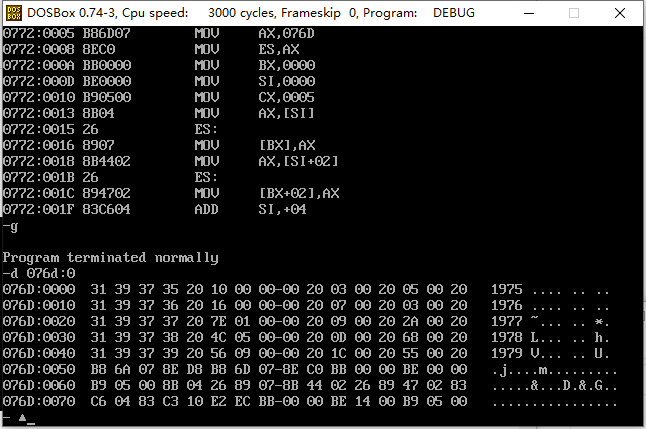Experimental task 1
Task 1-1:
To program task1_1.asm assembles and connects, loads and tracks debugging with debug, and answers questions based on the results.
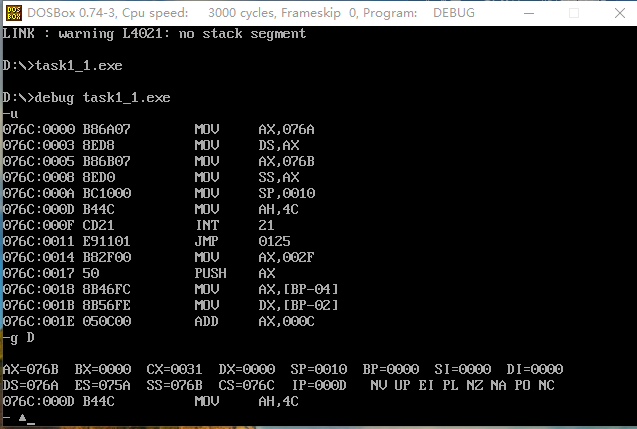
question answering:
1. In debug, execute until the end of line17 and before line19. Record this time: register (DS) =__ 076A__, Register (SS) =__ 076B__, Register (CS) =__ 076C__
2. Assuming that the segment address of the code segment is X after the program is loaded, the segment address of the data segment is X__ X-2__, The segment address of stack is__ X-1__.
Task 1-2:
To program task1_2.asm assembles and connects, loads and tracks debugging with debug, and answers questions based on the results.
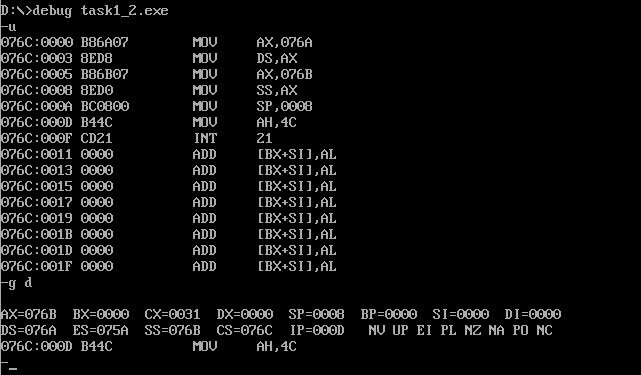
question answering:
① In debug, execute until the end of line17 and before line19. Record this time: register (DS) =__ 076A__, Register (SS) =__ 076B__, Register (CS) =__ 076C__
② Assuming that the segment address of the code segment is X after the program is loaded, the segment address of the data segment is X__ X-2__, The segment address of stack is__ X-1__.
Tasks 1-3:
To program task1_3.asm assembles and connects, loads and tracks debugging with debug, and answers questions based on the results.

question answering:
① In debug, execute until the end of line17 and before line19. Record this time: register (DS) =__ 076A__, Register (SS) =__ 076C__, Register (CS) =__ 076E__
② Assuming that the segment address of the code segment is X after the program is loaded, the segment address of the data segment is X__ X-4__, The segment address of stack is__ X-2__.
Tasks 1-4:
To program task1_4.asm assembles and connects, loads and tracks debugging with debug, and answers questions based on the results.
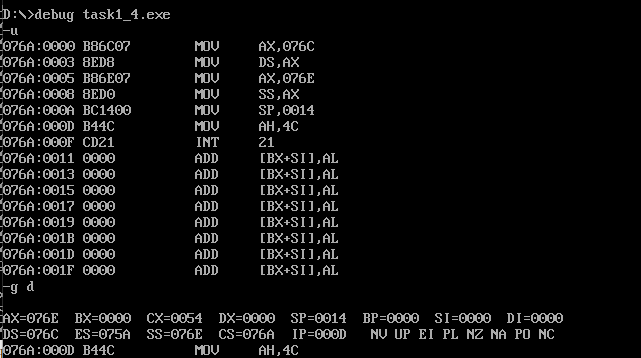
question answering:
① In debug, execute until the end of line17 and before line19. Record this time: register (DS) =__ 076C__, Register (SS) =__ 076E__, Register (CS) =__ 076A__
② Assuming that the segment address of the code segment is X after the program is loaded, the segment address of the data segment is X__ X+2__, The segment address of stack is__ X+4__.
Tasks 1-5
Based on the practice and observation of the above four experimental tasks, summarize and answer:
① For the segment defined below, after the program is loaded, the actual memory space allocated to the segment is_ (N/16) rounded up _.
② After the pseudo instruction end start is changed to end:
task1_1 screenshot:
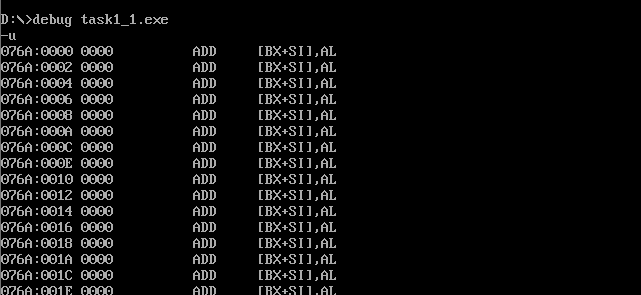
task1_2 screenshot:
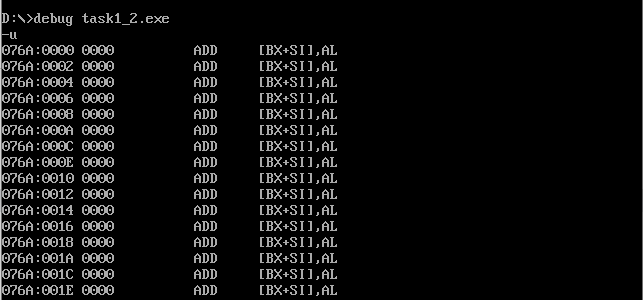
task1_3 screenshot:
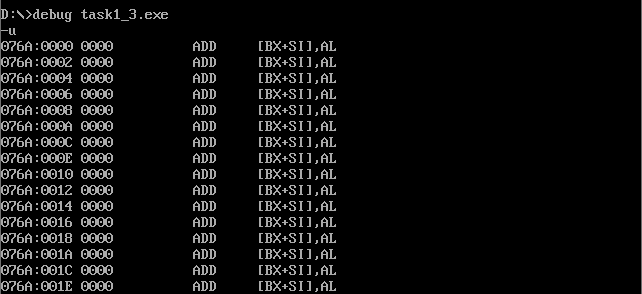
task1_4 screenshot:
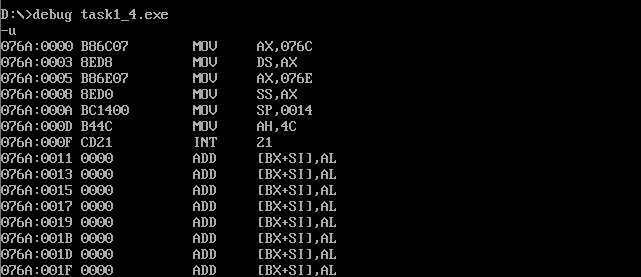
According to the screenshot, only Task1_ 4. The ASM program can still be executed correctly. This is because of task 1_ 1 to task 1_ 3 defines data segments first and then code segments, while task 1_ 4 is to define code segments first and then data segments. end start tells the program that the code starts from start. After writing end, the program will compile from the first line. Because task 1_ 4 code snippet is written in front, and compiling from the first line is not affected.
Experiment task 2
Write an assembly source program to realize 160 consecutive bytes to memory units b800:0f00 ~ b800:0f9f, and fill hexadecimal data 03 and 04 repeatedly in turn.
Experimental code
assume cs:code
code segment
mov ax, 0b800h
mov ds, ax
mov bx, 0f00h
mov cx, 160
s: mov ax, 0403h
mov [bx], ax
add bx, 2h
loop s
mov ax,4c00h
int 21h
code ends
end
Screenshot of experimental results:

Experimental task 3
It is known that the 8086 assembly source program task3.asm code fragment is as follows.
task3.asm
assume cs:code
data1 segment
db 50, 48, 50, 50, 0, 48, 49, 0, 48, 49 ; ten numbers
data1 ends
data2 segment
db 0, 0, 0, 0, 47, 0, 0, 47, 0, 0 ; ten numbers
data2 ends
data3 segment
db 16 dup(0)
data3 ends
code segment
start:
; ×××
mov ah, 4ch
int 21h
code ends
end start
requirement:
① The programming adds the data of logical segment data1 and logical segment data2 in turn, and the results are saved in logical segment data3.
② Load, disassemble and debug in debug. Before and after the data items are added in turn, check the memory space corresponding to the three logical segments data1, data2 and data3 respectively. After adding them one by one, ensure that the results exist in the logical segment data3.
code:
assume cs:code data1 segment db 50, 48, 50, 50, 0, 48, 49, 0, 48, 49 ; ten numbers data1 ends data2 segment db 0, 0, 0, 0, 47, 0, 0, 47, 0, 0 ; ten numbers data2 ends data3 segment db 16 dup(0) data3 ends code segment start: mov bx,0 mov cx,10 mov dx,0 s:mov dx,0 mov ax,data1 mov ds,ax add dl,[bx] mov ax,data2 mov ds,ax add dl,[bx] mov ax,data3 mov ds,ax mov [bx],dl inc bx loop s mov ax,4c00h int 21h code ends end start end start
View results:
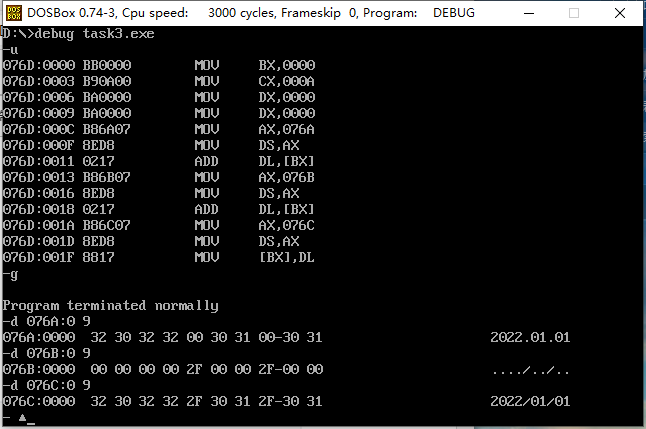
According to the operation results, the experimental requirements have been completed.
Experimental task 4
It is known that the 8086 assembly source program task4.asm code fragment is as follows.
task4.asm
assume cs:code data1 segment dw 2, 0, 4, 9, 2, 0, 1, 9 data1 ends data2 segment dw 8 dup(?) data2 ends code segment start: ; ××× mov ah, 4ch int 21h code ends end start
requirement:
① Complete the program to store the eight word data in logical segment data1 in reverse order in logical segment b.
② After assembly and connection, load the program in debug and run it to line15. Before the program exits, use the d command to check the memory space corresponding to data segment data2 to confirm whether the subject requirements are met.
Completed code:
assume cs:code data1 segment dw 2, 0, 4, 9, 2, 0, 1, 9 data1 ends data2 segment dw 8 dup(?) data2 ends code segment start: mov ax,data2 mov ss,ax mov sp,10h mov ax,data1 mov ds,ax mov bx,0 mov cx,8 s: push [bx] add bx,2 loop s mov ah, 4ch int 21h code ends end start
Result screenshot:
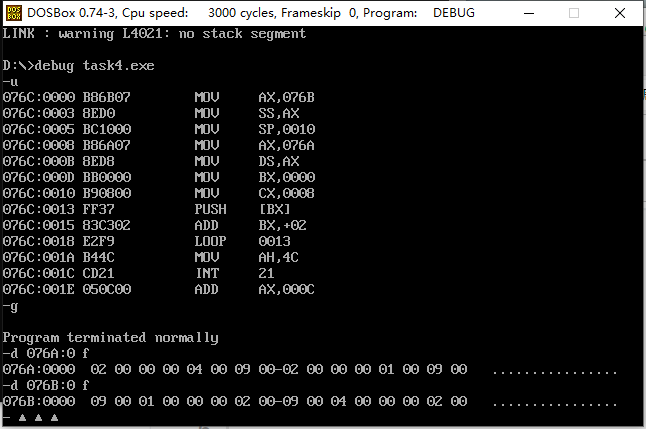
It can be seen from the figure that the requirements have been realized
Experiment task 5
Use any text editor to enter the assembly source program task5.asm.
task5.asm
assume cs:code, ds:data data segment db 'Nuist' db 2, 3, 4, 5, 6 data ends code segment start: mov ax, data mov ds, ax mov ax, 0b800H mov es, ax mov cx, 5 mov si, 0 mov di, 0f00h s: mov al, [si] and al, 0dfh mov es:[di], al mov al, [5+si] mov es:[di+1], al inc si add di, 2 loop s mov ah, 4ch int 21h code ends end start
Read the source program, theoretically analyze the functions of the source code, especially line15-25, what are the functions realized by the loop, and understand the functions of each instruction line by line.
Assemble and link the program to get the executable file, run and observe the results.
Use the debug tool to debug the program and observe the results before the program returns, that is, after line25 and before line27.
What is the function of line19 in the source code?
Modify the value of 5 byte units in line4, reassemble, link, run and observe the results.
db 2,3,4,5,6 --> Change to: db 5 dup(2) or db 5 dup(5)
Based on observation, analyze and guess what the numerical function here is.
Assemble and link the program to get the executable file. The running results are as follows

Use the debug tool to debug the program. Before the program returns, that is, after line25 and before line27, the observation results are as follows
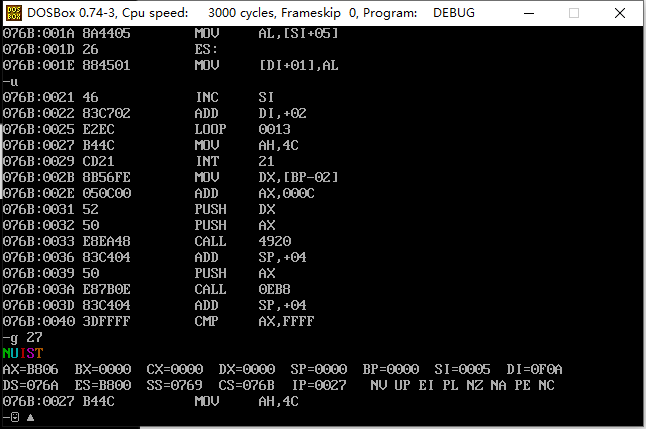
The function of line19 in the source code is to change lowercase letters into uppercase letters
Change the of line4 to db 5 dup(2), and the result screenshot is as follows:
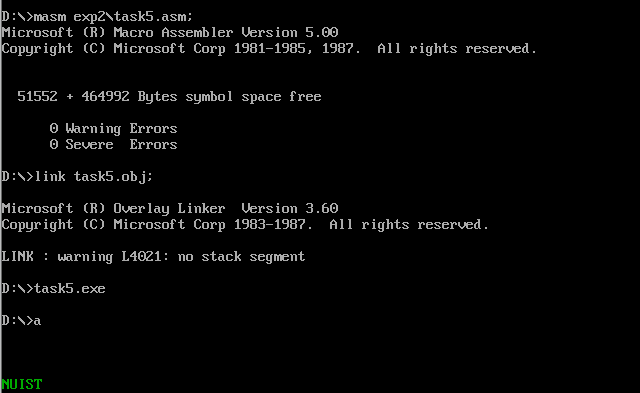
As can be seen from the figure, the command of this statement is to change the font color.
Experimental task 6
It is known that the 8086 assembly source program task6.asm code fragment is as follows.
task6.asm
1 assume cs:code, ds:data 2 3 data segment 4 db 'Pink Floyd ' 5 db 'JOAN Baez ' 6 db 'NEIL Young ' 7 db 'Joan Lennon ' 8 data ends 9 10 code segment 11 start: 12 ; ××× 13 mov ah, 4ch 14 int 21h 15 code ends 16 end start
requirement:
① Complete the program and change the first word of each line in the data section from uppercase to lowercase.
② Load the program in debug, disassemble it, and check the memory space corresponding to the data section with the d command before exiting line13. Confirm that the first word in each line has changed from uppercase to lowercase.
The code after completion is as follows:
1 assume cs:code, ds:data 2 3 data segment 4 db 'Pink Floyd ' 5 db 'JOAN Baez ' 6 db 'NEIL Young ' 7 db 'Joan Lennon ' 8 data ends 9 10 code segment 11 start: 12 mov ax, data 13 mov ds,ax 14 mov bx, 0 15 mov cx, 4 16 17 s0:mov dx,cx 18 mov cx,4 19 mov si,0 20 21 s: or byte ptr [bx+si], 00100000b 22 inc si 23 loop s 24 add bx,10h 25 mov cx,dx 26 loop s0 27 28 mov ah, 4ch 29 int 21h 30 code ends 31 end start
The operation results are as follows
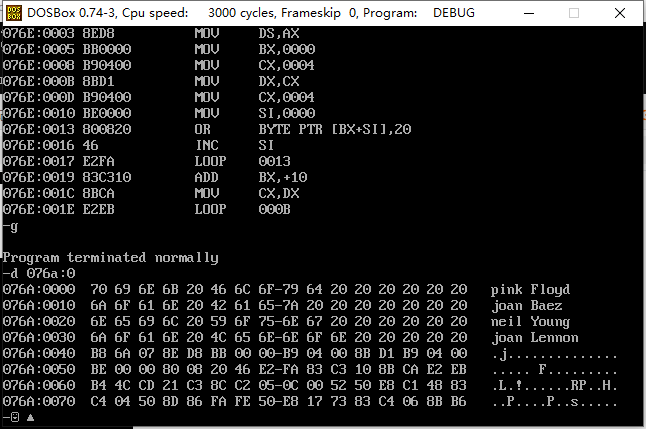
The screenshot shows that the effect has been improved.
Experimental task 7
requirement:
① Complete the program, realize the title requirements, and write the year, income, number of employees and per capita income into the table section in a structured way. In the table, each row of data occupies 16 bytes in the logical segment table, and the byte size of each data is allocated as follows. During the period, the data is separated by spaces.
② After assembly and connection, load and debug the program in debug. Use the u command, g command and d command flexibly and reasonably to display the data information of the logical segment table at the beginning, and the data information of the data segment table after structurally storing the data to confirm the realization of the subject requirements.
The experimental code is as follows
1 assume cs:code, ds:data, es:table 2 3 data segment 4 db '1975', '1976', '1977', '1978', '1979' 5 dw 16, 22, 382, 1356, 2390 6 dw 3, 7, 9, 13, 28 7 data ends 8 9 table segment 10 db 5 dup( 16 dup(' ') ) ; 11 table ends 12 13 code segment 14 start: 15 16 mov ax, data 17 mov ds, ax 18 mov ax, table 19 mov es, ax 20 21 mov bx, 0 ;particular year 22 mov si, 0 23 mov cx, 5 24 s0:mov ax, [si] 25 mov es:[bx], ax 26 mov ax, [si+2] 27 mov es:[bx+2], ax 28 add si, 4 29 add bx, 10h 30 loop s0 31 32 mov bx, 0 ;income 33 mov si, 14h 34 mov cx, 5 35 s1:mov ax, [si] 36 mov es:[bx+5], ax 37 mov ax, 0 38 mov es:[bx+5+2], ax 39 add si, 2 40 add bx, 10h 41 loop s1 42 43 mov bx, 0 ;Number of employees 44 mov si, 1eh 45 mov cx, 5 46 s2:mov ax,[si] 47 mov es:[bx+0ah], ax 48 add si, 2 49 add bx, 10h 50 loop s2 51 52 mov bx, 0 ;Seeking quotient 53 mov cx, 5 54 s3:mov ax, es:[bx+5] 55 mov dx, es:[bx+5+2] 56 div word ptr es:[bx+0ah] 57 mov es:[bx+0dh], ax 58 add bx, 10h 59 loop s3 60 61 mov ah, 4ch 62 int 21h 63 code ends 64 end start
Screenshot of experimental results:
